Paint Shop – 61 : Minneapolis & St Louis Boxcar 2520, part 2 [Works_Boxcars]
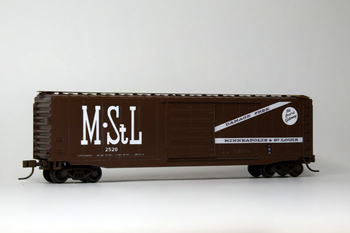
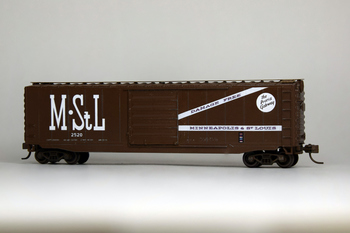 : MSTL 2520
: MSTL 2520Here are the data of the car and a belief history of the railroad.
MSTL 2500 - 2520 series Boxcars:
2500 – 2520 series boxcars were built in two series, 2500/2502 and 2504 – 2520 by Pullman-Standard in 1957 and 1959. The difference between the two other than the built-date is uncertain.
The ORER for July 1974 shows the group #2500 to #2020 with 5 cars in place, described as follows:
AAR Designation XL, Box, 9 Belt DF Loaders. The inside length of these cars is 50 feet 6 inches, inside width 9 feet 2 inches, inside height 10 feet 5 inches, outside length 54 feet 4 inches, extreme height 14 feet 10 inch and capacity 4840 cubic feet or 100,000 pounds.
Minneapolis & St Louis Railway
See Paint Shop – 59 : Minneapolis & St Louis Boxcar 2048, part 2
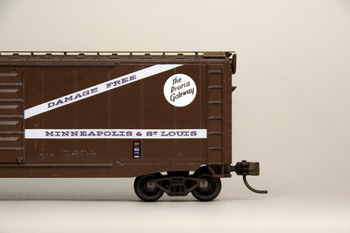 : MSTL 2520
: MSTL 25202017-09-01 09:00
コメント(0)
Paint Shop – 62 : Gulf Mobile & Ohio Boxcar 9077, part 1 [Works_Boxcars]
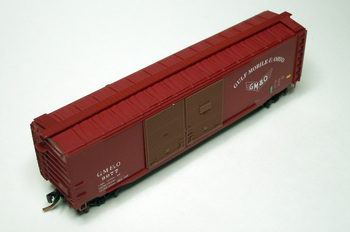 : completed model
: completed modelGM&O boxcars are rich in their graphic variation: what drives me modeling GM&O boxcars is the variation brought about by the combination of the Wings Herald, the arched lettered roadname, and the reporting mark.
The reporting mark GM&O is always at the left as the norm and the Wings Herald seems always at the right, according to the IC/GM&O Color Guide to Freight and Passenger Equipment (MSCG). But the position of the arched lettered roadname is not fixed. Moreover, Wings are sometimes lacked.
For example, GM&O 9077 repainted at Frascati Shops in 1968 had both the arched lettered roadname and the Herald at the right according to the 1972 prototype photo found in the book MSCG. The same photo is found at the Railroad Picture Archives web site.
I used surplus Micro-Trains #078 series 50' Auto Box Car w/Double Side Doors & End Door for the model. I changed the ends with copied and modified Stanray 3/4 pressed improved Dreadnaught ends from Micro-Trains #069 series body. I also changed the roof with the diagonal panel roof copied from Athearn NACC boxcar and added the sill.
I spray painted the body with Mr. Color Spray No. 81. I polished the surface of the painted body, where decals were going to be applied, with the compound before applying the decal for the better adhesion. Decal used is Microscale #60-1506 introduced in June 2015. I spray painted the semi-gloss clear coat after applying the decal. Doors keep the original MTL decoration; #078 00 110, Erie 68000.
Athearn produced the exact car in N scale as ATH-2795 in Oct. 2021.
* 1972 prototype photo of GM&O 9077 found at Railroad Picture Archives web site;
* the decal I used;
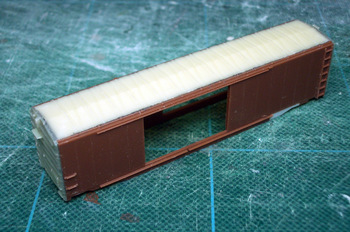 : body ready to paint
: body ready to paint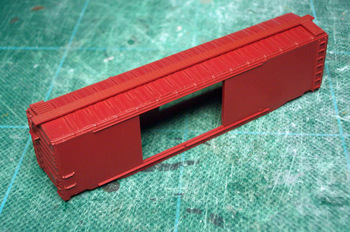 : painted body
: painted body2019-08-02 09:00
コメント(0)
Paint Shop – 63 : Gulf Mobile & Ohio Boxcar 9077, part 2 [Works_Boxcars]
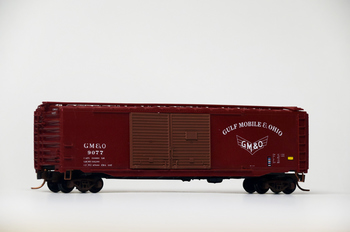 : GM&O 9077
: GM&O 9077Here are the data of the car and a belief history of the railroad.
GM&O 9000 - 9199 series boxcars:
According to the IC/GM&O Color Guide to Freight and Passenger Equipment, the GM&O series 9000 to 9199 boxcars were built in 1950 by AC&F.
The Official Railway Equipment Register (ORER) for April 1974 shows the group #9008 to #9198 with 42 cars in place, described as follows:
AAR Designation XM and description “Box” only. The inside length of both of these cars was 50 feet 6 inches, inside width 9 feet 2 inches, inside height 10 feet 6 inches, outside length 54 feet 4 inches, extreme height 15 feet, door opening 15 feet, and capacity 4845 cubic feet or 110,000 pounds.
Gulf Mobile & Ohio Railroad (reporting mark GM&O) was primarily a North-South route connecting New Orleans, Louisiana, Mobile, Alabama, St. Louis, Missouri, and Chicago, Illinois.
Gulf Mobile & Northern Railroad incorporated in 1917 is the root of GM&O. GM&N merged with Mobile & Ohio Railroad established in 1848 to form the GM&O in 1940. GM&O acquired the Alton Railroad in 1947, therefore, the railroad obtained the Chicago gateway. In 1972, GM&O merged with Illinois Central Railroad and formed Illinois Central Gulf Railroad. The route is now part of Canadian National Railway network.
The map below is the part of “Union Pacific Map of the United States” printed in 1971, with the GM&O route traced in green line by the author.
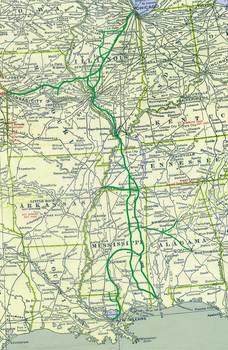 : GM&O route
: GM&O route2019-08-09 09:00
コメント(0)
Paint Shop – 64 : Gulf Mobile & Ohio Boxcar 54226, part 1 [Works_Boxcars]
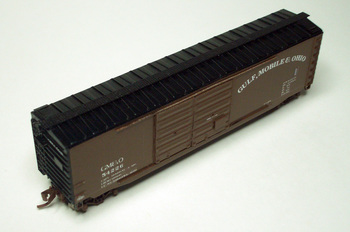 : completed model
: completed modelGM&O boxcars are rich in their graphic variation: what drives me modeling GM&O boxcars is the variation brought about by the combination of the Wings Herald, the arched lettered roadname, and the reporting mark.
The reporting mark GM&O is always at the left as the norm and the Wings Herald seems always at the right, according to the IC/GM&O Color Guide to Freight and Passenger Equipment (MSCG). But the position of the arched lettered roadname is not fixed. Moreover, Wings are sometimes lacked.
For example, GM&O 54226 had the arched lettered roadname at the right but lacked the Herald according to the 1962 prototype photo found in the book MSCG. The photo of 54268 from the same series at Railroad Picture Archives web site shows the 1978 style: doors changed, roofwalk removed, ladders shortened, and the large DF stencil added.
I used surplus Athearn PS-1 plug-door boxcar for the model. I changed the doors with copied and modified 8’ Pullman doors produced by Atlas to represent the 7’+8’ Pullman doors.
I spray painted the body with Tamiya TS-33. The roof and the ends are painted black (TS-14). I polished the surface of the painted body, where decals were going to be applied, with the compound before applying the decal for the better adhesion. Decal used is Microscale #60-1506 introduced in June 2015. I spray painted the semi-gloss clear coat after applying the decal.
* 1978 prototype photo of GM&O 54268 found at Railroad Picture Archives web site;
* the decal I used;
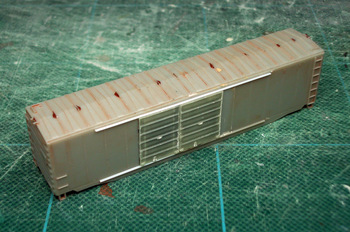 : body ready to paint
: body ready to paint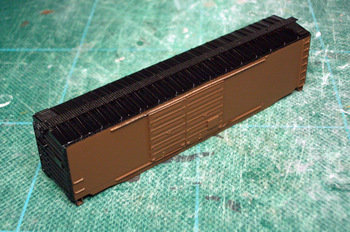 : painted body
: painted body2019-08-16 09:00
コメント(0)
Paint Shop – 65 : Gulf Mobile & Ohio Boxcar 54226, part 2 [Works_Boxcars]
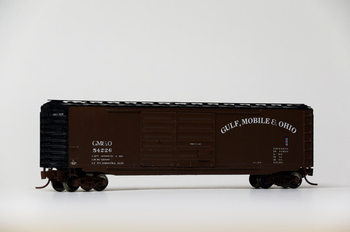 : GM&O 54226
: GM&O 54226Here are the data of the car and a belief history of the railroad.
GM&O 54100 - 54299 series boxcars:
According to the IC/GM&O Color Guide to Freight and Passenger Equipment, the GM&O series 54100 to 54299 boxcars were built in 1961 by Pullman-Standard.
The Official Railway Equipment Register (ORER) for April 1974 shows the group 54100 to 54299 with 183 cars out of possible 200 in place, described as follows:
AAR Designation XL and description “Box, 4 Belt DF-2 Loaders, Lading Strap Anchors”. The inside length of both of these cars was 50 feet 6 inches, inside width 9 feet 4 inches, inside height 10 feet 5 inches, outside length 54 feet 6 inches, extreme height 15 feet, door opening 15 feet, and capacity 4932 cubic feet or 110,000 pounds.
Gulf Mobile & Ohio Railroad
See Paint Shop – 63 : Gulf Mobile & Ohio Boxcar 9077, part 2
2019-08-23 09:00
コメント(0)
Paint Shop – 66 : Gulf Mobile & Ohio Boxcar 56345, part 1 [Works_Boxcars]
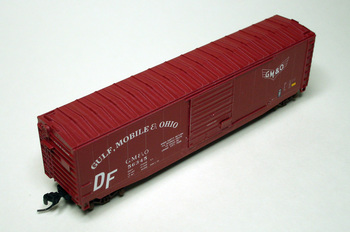 : completed model
: completed modelGM&O boxcars are rich in their graphic variation: what drives me modeling GM&O boxcars is the variation brought about by the combination of the Wings Herald, the arched lettered roadname, and the reporting mark.
The reporting mark GM&O is always at the left as the norm and the Wings Herald seems always at the right, according to the IC/GM&O Color Guide to Freight and Passenger Equipment. But the position of the arched lettered roadname is not fixed. Moreover, Wings are sometimes lacked.
For example, GM&O 56345 had the Herald on the right and the roadname on the left. The 1983 prototype photo of the particular car was found at Illinois Central Gulf Decals web site. However, unfortunately, the ICG Decals produces HO scale only. Accordingly I went to Microscale Industries; Microscale announced the N scale decals for GM&O boxcars in June 2015.
I used surplus Athearn PS-1 single-door boxcar for the model. I changed the door with copied and modified 8’ Pullman door produced by Atlas. I also removed the roofwalk as seen in the prototype photo.
I spray painted the body with Mr. Color Spray No. 81. I polished the surface of the painted body, where decals were going to be applied, with the compound before applying the decal for the better adhesion. Decal used is Microscale #60-1506. I spray painted the semi-gloss clear coat after applying the decal.
* 1983 prototype photo of GM&O 56345 found at Illinois Central Gulf Decals web site;
* the decal I used;
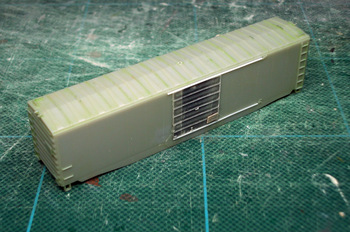 : body ready to paint
: body ready to paint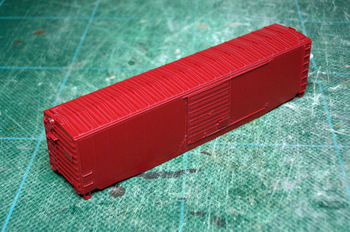 : painted body
: painted body2019-08-30 09:00
コメント(0)
Paint Shop – 67 : Gulf Mobile & Ohio Boxcar 56345, part 2 [Works_Boxcars]
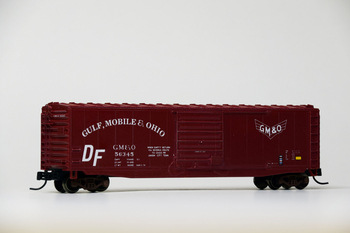 : GM&O 56345
: GM&O 56345Here are the data of the car and a belief history of the railroad.
GM&O 56200 - 56399 series boxcars:
These cars were built by Pullman-Standard in 1962.
The Official Railway Equipment Register (ORER) for April 1974 shows the group #56200 to #56399 with 136 cars in place, accompanied by other 49 cars with the same dimensions but with the description “Box, 4 Belt DF-2 Loaders, Lading Strap Anchors” and designation XL, described as follows:
AAR Designation XM and description “Box, Lading Strap Anchors”. The inside length of both of these cars was 50 feet 6 inches, inside width 9 feet 4 inches, inside height 10 feet 5 inches, outside length 54 feet 6 inches, extreme height 15 feet 1 inch, door opening 9 feet, and capacity 4932 cubic feet or 110,000 pounds.
Gulf Mobile & Ohio Railroad
See Paint Shop – 63 : Gulf Mobile & Ohio Boxcar 9077, part 2
2019-09-06 09:00
コメント(0)
Paint Shop – 68 : Clinchfield Railroad Boxcar 5680, part 1 [Works_Boxcars]
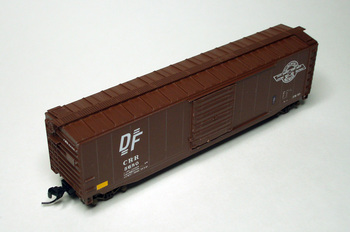 : completed model
: completed modelMy previous CRR boxcar project left quite a quantity of letterings including the “QUICK SERVICE” Herald on the decal sheet. So, I decided to consume some of them this time.
A photo of CRR #5655 but in poor shape is found at Railroad Picture Archives web site: it is covered by rust all over the body. So, I decided to make CRR #5680 from the same series found in my prototype photo stock: the “QUICK SERVICE” Herald is clearly shown in the photo. However, unfortunately, I can’t represent the particular photo here because it was pulled from an eBay site which I missed bidding.
I used a surplus Athearn PS-1 single-door boxcar for the model. I changed the door with copied and modified 8’ Pullman door produced by Atlas.
I tried using glue (Cemedine Black Super X Adhesive) to fill the gap of the door: wiping out the excess with Kimwipe and IPA (Isopropyl Alcohol) after applying the glue on the gap. I think this method is somewhat useful when you don’t want to lose the existing details like rivets or seams by filing.
I spray painted the body with Tamiya TS-62. I polished the surface of the painted body, where decals were going to be applied, with the compound before applying the decal for the better adhesion. Decal used is Microscale #60-966. “DF” stencil came from Microscale #60-1506. I spray painted the semi-gloss clear coat after applying the decal.
* 2003 photo of CRR #5655 but in poor shape found at Railroad Picture Archives web site;
* the decal I used;
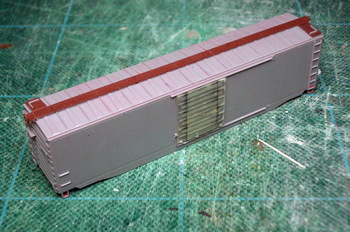 : body ready to paint
: body ready to paint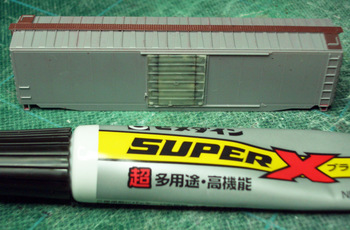 : gap on the door filled with glue
: gap on the door filled with glue2020-03-13 09:00
コメント(0)
Paint Shop – 69 : Clinchfield Railroad Boxcar 5680, part 2 [Works_Boxcars]
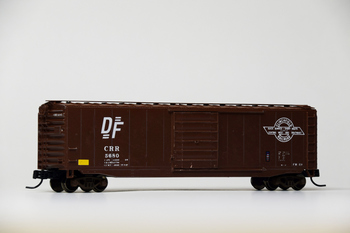 : CRR 5680
: CRR 5680Here are the data of the car and the belief history of the railroad.
CRR 5660 - 5684 series boxcars:
The CRR series 5660 to 5684 boxcars were built in 1960 by Pullman-Standard and ride on A-3 Ride Control trucks.
The Official Railway Equipment Register (ORER) for April 1974 shows the group #5660 to #5684 with 11 cars out of possible 25 in place, accompanied by 9 other cars, 5662 5667 5671 5673 5674 5677-5680, with the same description but 110,000 pounds capacity and 4 other cars, 5672 5676 5683 5684, with the same dimensions but with the description “Box, Stl, 28 Removable Metal Containers, (Dry Chemicals)”, described as follows:
AAR designation XL and description “Box, Stl” only.
The inside length of both of these cars was 50 feet 6 inches, inside width 9 feet 4 inches, inside height 10 feet 6 inches, outside length 51 feet 1 inch, extreme height 15 feet, door opening 9 feet, and capacity 4949 cubic feet or 100,000 pounds.
Clinchfield Railroad (reporting mark CRR)
See Paint Shop – 13: Clinchfield Boxcar 7011, part 2
2020-03-20 09:00
コメント(0)
Paint Shop – 70 : Pennsylvania Railroad Boxcar 32123, part 1 [Works_Boxcars]
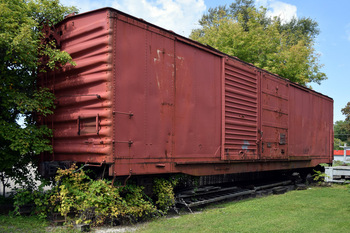 : PRR 32123
: PRR 32123This is the project using my archival photos of PRR XL #32123 appeared in my previous article. I also referred to other photos found on the web: 2012 photo of the particular car at Flickr and 1987 photo of PRR #32082 at Railroad Photo Archives which I mentioned in my article.
I used a surplus Athearn PS-1 double-door boxcar for the model. I changed one door with 8’ Superior door produced by MTL. I replaced the ends with copied and modified MTL 51’ 3¾” Mechanical Reefer ends. The roof is replaced with an overhanging diagonal panel roof copied from Athearn NACC boxcar. I also added the side sills referring to the prototype. Stirrups are the BLMA product. I corrected the side panel joints based on the prototype. New rivets on sides are the Archer product.
I painted the body with Tamiya TS-69. Before applying decals, I polished the surface of the painted body, where decals were going to be applied, with the compound. Decal used is Microscale #60-1205. I spray painted the semi-gloss clear coat after applying the decals.
* 2012 photo of the particular car at Flickr;
* 1987 photo of PRR #32082 at Railroad Photo Archives;
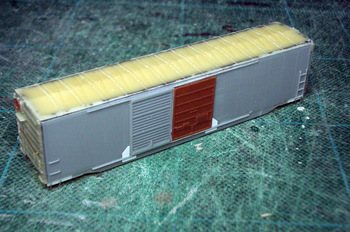 : modified body before applying rivet decals
: modified body before applying rivet decals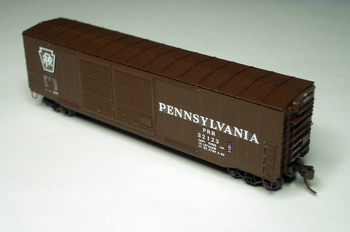 : finished model
: finished model2020-06-26 09:00
コメント(0)
Paint Shop – 71 : Pennsylvania Railroad Boxcar 32123, part 2 [Works_Boxcars]
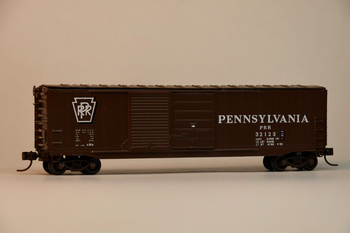 : PRR 32123
: PRR 32123Here are the data of the car and the belief history of the railroad.
PRR X55a Class 32000 - 32699 series boxcars:
According to the PRR Color Guide to Freight and Passenger Equipment Vol. 2, PRR X55a boxcars were built in 1960 by the Railroad’s Samuel Rea Shops at Hollidaysburg, PA.
The Official Railway Equipment Register (ORER) for April 1974 shows the group #32002 to #32699 with 411 cars in place, accompanied by other two cars #32004 and 32005 with the same dimensions but with the description “Box, Stl., Evans 19 Belt Rail DF Loaders, Nailable Stl., Flrs. Full Length, Assigned Service, X55a, Considered Part of Car. Pallets, (Auto Parts)”, described as follows:
AAR designation XL and description “Box, Stl., Evans 19 Belt Rail DF Loaders, Nailable Stl., Flrs. Full Length, X55a, (Auto Parts)”. The inside length of these cars was 50 feet 6 inches, inside width 9 feet 2 inches, inside height 10 feet 6 inches, outside length 54 feet 6 inches, extreme height 15 feet 1 inch, door opening 15 feet, and capacity 4860 cubic feet or 90,000 pounds.
Pennsylvania Railroad (reporting mark PRR) was established in 1846 and the route from Philadelphia to Pittsburgh, both in Pennsylvania, was completed by 1854. The Railroad reached Chicago, Illinois in 1869, and both Cincinnati, Ohio, and St. Louis, Missouri next year.
Through the mergers and acquisitions, the Railroad became the largest in the world by its traffic and revenue to called “The Standard Railroad of the World”. However, unfortunately, in 1968, the Railroad and the New York Central Railroad merged to establish Penn Central Transportation Company only to survive the next eight years before the coalition of the Consolidated Rail Corporation (Conrail). Most of the PRR route is now part of the Norfolk Southern Railway network.
The map below is the part of Union Pacific Map of the United States printed in 1971, with the PRR route traced in red line by the author.
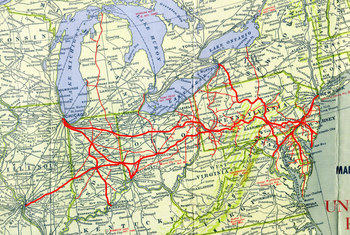 : PRR route
: PRR route2020-07-03 09:00
コメント(0)
Paint Shop – 72 : Pennsylvania Railroad Boxcar 72732, part 1 [Works_Boxcars]
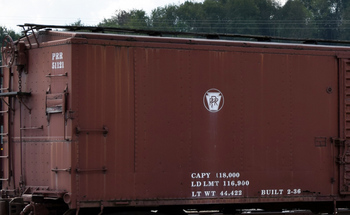 : Sugarcreek, OH. Sep. 7, 2019
: Sugarcreek, OH. Sep. 7, 2019Here is another PRR boxcar managed to present, this time with the classic Circle(Ball) Keystone Herald lasted until January 1954: I had a stock Circle Keystone Herald decal produced by Gerald Glow who went out of business in 2016. Glow’s decal line is now provided by Tichy Train Group.
I chose Class X47, #72680-72999 series boxcars built in 1953 for the prototype of the model because it is the last equipment built new with Circle Keystone Herald. The Circle Herald on equipment might not survive into the ’70s, but the beautiful B/W builder’s photos of #72732 found at Hagley Digital Archives led me to model the particular car.
* 1953 photo of PRR #72732 found at Hagley Digital Archives site;
* 1974 photo of PRR #72851 from the same class but repainted to the “Plain Keystone” scheme found at Boxcars & Freight Cars of North America site;
* 1999 photo of condemned PRR #72870, later CR #146662 found at Conrail Historical Society site;
I used stock MTL 51’3¾” Rib Side Mechanical Reefer for the model. If you ignore the length, its ends, roof, and straight sill are the great advantages for the accuracy of the model. MTL #069 Rivet Side Reefer would be much better, no need to remove the ribs.
After removing all the details from the sides, I applied the 8’ Youngstown Door copied from Athearn PS-1 double-door boxcar. New door rails, strengthen plates, and trust plate badge are made out of thin styrene. New rivets on sides are the Archer product. I also removed the details from the diecast frame and added the MTL 50’ Underbody Subframe.
 : body ready to paint
: body ready to paint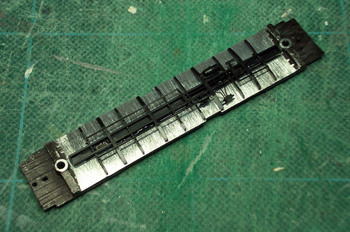 : modified underframe
: modified underframeI spray painted the body with Tamiya TS-33. I polished the surface of the painted body, where decals were going to be applied, with the compound before applying the decal for the better adhesion. Decal used is Gerald Glow, today Tichy #10012N. Some letters came from stock Microscale decals. I spray painted the matt clear coat after applying the decal and slightly polished with the compound as the weathering.
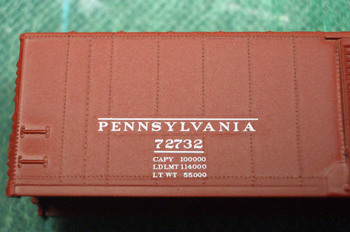 : body matt coated
: body matt coated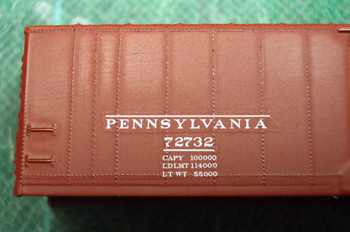 : body polished
: body polished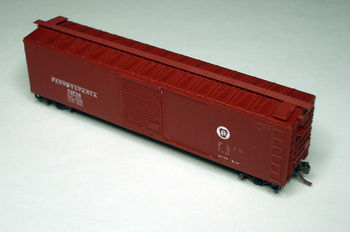 : finished model
: finished model2020-07-10 09:00
コメント(0)
Paint Shop – 73 : Pennsylvania Railroad Boxcar 72732, part 2 [Works_Boxcars]
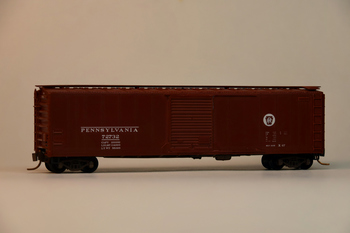 : PRR 72732
: PRR 72732Here are the data of the car and the belief history of the railroad.
PRR X47 Class 72680 - 72999 series boxcars:
PRR X47 boxcars were built in 1953 by the Railroad.
The Official Railway Equipment Register (ORER) for April 1974 shows the group #72680 to #72999 with 88 cars in place, accompanied by other 87 cars in five groups, described as follows:
AAR designation XM and description “Box, Stl., X47” only. The inside length of these cars was 50 feet 6 inches, inside width 9 feet 2 inches, inside height 10 feet 6 inches, outside length 54 feet 6 inches, extreme height 15 feet, door opening 8 feet, and capacity 4860 cubic feet or 100,000 pounds.
Pennsylvania Railroad (reporting mark PRR)
See Paint Shop – 71 : Pennsylvania Railroad Boxcar 32123, part 2
2020-07-17 09:00
コメント(0)
Paint Shop – 74 : Georgia Railroad Boxcar 55172, part 1 [Works_Boxcars]
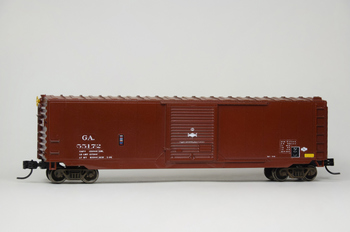 : GA 55172
: GA 55172This is a model of a boxcar decorated with the decal produced by Gerald Glow: Georgia Railroad #55172.
Jerry produced the decal as “GA 40’ Steel Boxcar Decal Blt. 1924”. Accordingly, I searched for a prototype meeting my body type, scheme, and era: 50’ boxcar red boxcar with ACI plates.
I found several prototype photos in books and on the web. However, unfortunately, the only photo able to adopt for the model was the 1975 photo of GA #55172 sold at eBay a few years ago. Jerry’s decal features roman letters but most of the “my era” prototypes have gothic letters. Accordingly, I decided to model a particular car.
The photo shows the body style very similar to PS-1 except for the sill. According to Gautreaux, the particular car was built as PS-4923[1]. Therewith, I added a styrene tip to the sill of Athearn PS-1 Single Door Boxcar and took the roofwalk off. I also changed the brake wheel to accommodate the ease of painting. Tracks are changed to MTL Roller Bearing Trucks except for the metal wheels.
I spray painted the body with Tamiya TS-33. The brake wheel is painted yellow. I polished the surface of the painted body, where decals were going to be applied, with the compound before applying the decal for better adhesion. Decal used is Gerald Glow, today Tichy #10061N, and some stock Microscale decals as listed below:
・reporting mark side/end: Gerald Glow (Tichy#10061N)
・number on the side: Microscale 60-1048 Soo Line Boxcars
・door size stencil: Microscale 60-1048 Soo Line Boxcars
・number on end: Microscale 60-506 Santa Fe Boxcars
・DF marking: Microscale 60-506 Santa Fe Boxcars
・lading strap anchors marking on the door: 60-506 Santa Fe Boxcars
・movable bulkheads marking on the door: Microscale 60-2 Data for freight Cars
・physical dimensions, built date: Microscale 60-2 Data for freight Cars
・data on end: Microscale 60-2 Data for freight Cars
・loading and weight dimensions, AAR designation, paint date: Microscale 60-2 Data for freight Cars
・consolidated stencil: Microscale 60-4268 DT&I Boxcars
・ACI plate: Microscale 60-4280 ACI Plates
・No Roofwalk stencil: Microscale 60-1 Data for freight Cars
Finally, I spray painted the model with gloss clear paint to represent the “painted new” condition shown in the prototype photo.
[1] Gautreaux, Lee A., Pullman-Standard 50’ Box Cars, RailGoat;
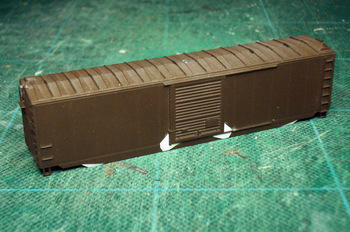 : body ready to paint
: body ready to paint2021-01-15 09:00
コメント(0)
Paint Shop – 75 : Georgia Railroad Boxcar 55172, part 2 [Works_Boxcars]
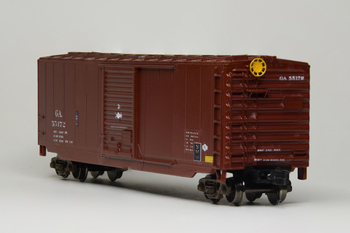 : GA 55172
: GA 55172Here are the data of the car and a belief history of the railroad.
GA 55100 - 55199 series boxcars:
GA class O–38 XL #55100 to 55199 series boxcars were built in 1965 by Pullman-Standard.
The Official Railway Equipment Register (ORER) for April 1974 shows the group #55100 to #55199 with 99 cars in place, described as follows:
AAR designation XL and description “Box, Stl., Evans DF-2 Loaders”. The inside length of these cars was 50 feet 6 inches, inside width 9 feet 4 inches, inside height 10 feet 6 inches, outside length 56 feet 9 inches, extreme height 15 feet 1 inch, door opening 9 feet, and capacity 4923 cubic feet or 154,000 pounds.
Georgia Railroad (reporting mark GA) connected Augusta, Atlanta, and Macon. The company was established in 1833 as the Georgia Railroad and Banking Company. It reached Atlanta, by then Marthasville in 1845. The company took control of Atlanta & West Point Railroad and Western Railway of Alabama to extend the “West Point Route” to Augusta in 1886.
Three railroads were acquired by Atlantic Coast Line Railroad and became subsidiaries of ACL in 1902. Finally, in 1982, GA merged into CSX and the name GA came to an end. The Banking Company sector was acquired by First Union in 1986. Most of the former GA Bank branches are operated as Wells Fargo today.
The map below is the part of Union Pacific Map of the United States printed in 1971, with the GA route traced in red line by the author.
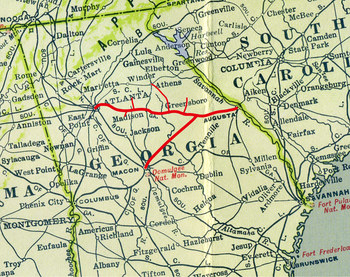 : 1966 GA route
: 1966 GA route2021-01-22 09:00
コメント(0)
Paint Shop – 76 : Atlanta & West Point Railroad Boxcar 39052, part 1 [Works_Boxcars]
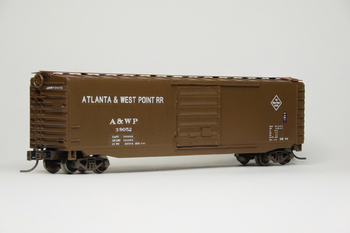 : A&WP 39052
: A&WP 39052This is a model of a boxcar also decorated with the decal produced by Gerald Glow: Atlanta & West Point Railroad #39052.
I managed to model a Western Railway of Alabama boxcar before. To complete the “West Point Route” citation, I arranged to model Atlanta & West Point Railroad equipment this time. Jerry produced the decal as “A&WP 40’ Steel Boxcar Decal Blt. 1924”. Searching a prototype meeting my body type, scheme, and era, 50’ boxcar red boxcar with ACI plates, led me to a 1974 photo of A&WP #39052 at Boxcars & Freight Cars of North America web site[1]. Accordingly, I decided to model the particular car.
I used a surplus Athearn PS-1 single-door boxcar for the model. I only changed the doors. I decided to mass-produce 9’ Pullman doors because my next projects also needed them. I used 8’ Pullman doors attached to Atlas master PS-1 40’ Boxcars. I first spliced them to a single 9’ wide door, next used silicone rubber to make molds, and finally cast 9’ doors with resin.
I spray-painted the body with Tamiya TS-1. Before applying decals, I polished the surface of the painted body, where decals were going to be applied, with compound. Decal used is by Gerald Glow (Tichy#10063N) as I mentioned above. I spray-painted the semi-gloss clear coat after applying the decals.
[1] 1974 photo of A&WP #39052 at Boxcars & Freight Cars of North America web site;
* 1960 builder's photo of A&WP #39068 at Illinois Digital Archives;
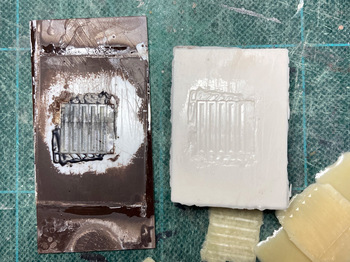 : Pullman door original, mold, and castings
: Pullman door original, mold, and castings2021-04-23 09:00
コメント(0)
Paint Shop – 77 : Atlanta & West Point Railroad Boxcar 39052, part 2 [Works_Boxcars]
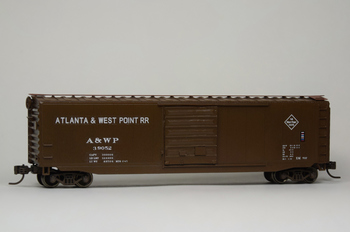 : A&WP 39052
: A&WP 39052Here are the data of the car and a belief history of the railroad.
A&WP 39050 - 39069 series boxcars:
A&WP XM #39050 to 39069 series boxcars were built in 1960 by Pullman-Standard.
The Official Railway Equipment Register (ORER) for April 1974 shows the group #39050 to #39069 with 19 cars in place, described as follows:
AAR designation XM and description “Box, Stl.” only. The inside length of these cars was 50 feet 6 inches, inside width 9 feet 4 inches, inside height 10 feet 6 inches, outside length 54 feet 4 inches, extreme height 15 feet, door opening 9 feet, and capacity 4933 cubic feet or 110,000 pounds.
Atlanta & West Point Railroad (reporting mark A&WP) connected namesake Georgia cities. The company was established in 1847 as the Atlanta & LaGrange Rail Road and was completed in 1854. Since 1886, it formed the “West Point Route” with the Western Railway of Alabama, both under the control of Georgia Railroad & Banking Company.
In 1983, after the long series of consolidating of the parent railroads, the name A&WP came to an end. The route itself remains in service today as part of the CSX system.
The map below is the part of Union Pacific Map of the United States printed in 1971, with the A&WP route traced in red line by the author.
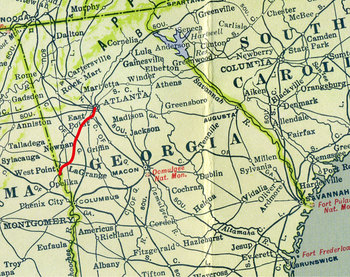 : 1966 A&WP route
: 1966 A&WP route2021-04-30 09:00
コメント(0)
Paint Shop – 78 : Georgia & Florida Railroad Boxcar 488, part 1 [Works_Boxcars]
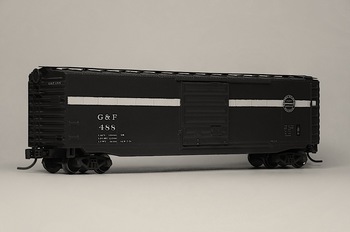 : G&F 488
: G&F 488This is a model of a boxcar decorated with the decal produced by Gerald Glow: Georgia & Florida #488.
Jerry produced the decal as “GA & FLA 40’ Steel Boxcar Decal Blt. 1944”. Accordingly, I searched for a prototype meeting my body type, scheme, and era: 50’ boxcar red boxcar with ACI plates.
According to 1974 Official Railway Equipment Roster, GF #400 to 499 XMs are listed in a series. I found several photos of a boxcar in this series and got into difficulties: in the same series but in four different schemes.
The undated photo of G&F #401 in the book Classic freight Cars the Series Vol. 8: 50Ft Boxcars shows its SOU-style scheme: painted boxcar red with letterings in white SOU-style gothic font. A 1969 photo of #468 and a 1974 photo of #473 found on the web also show them in SOU-style scheme.
A B/W 1971 photo of #425 is found at HawkinsRails web site[1]. According to the colorized photo, it seemed painted boxcar red with a white "cigar band"ーa narrow band around the bodyーand letterings in roman font to me. Or, it might possibly heavily weathered but kept its "cigar band" clean. Also is #488 according to the colorized 1964 B/W photo found at City of Vancouver Archives web site[2]. The "cigar band" boxcar scheme first appeared on PRR "Merchandise Service" boxcars in 1947, designed by Raymond Loewy (1893 − 1986).
A 1965 photo of #457 found on the web shows it was painted boxcar red with letterings in the white roman font but without "cigar band".
A 1970 photo of #437 and a 1972 photo of #490 found on the web show they were painted green with white "cigar band" and letterings in roman font. HO models produced by Kadee are also decorated in this scheme.
Eventually, I decided to model #488 trusting today’s information technology[3].
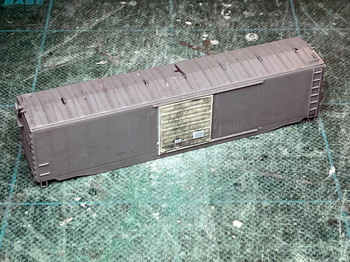 : body, ready to paint
: body, ready to paintI used a surplus Athearn PS-1 single-door boxcar for the model. I only changed the door with 9’ Pullman doors made from Atlas 40’ PS-1 boxcar attachment parts.
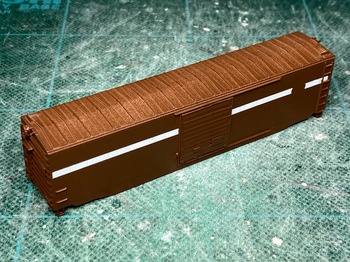 : body, ready to apply decal
: body, ready to apply decalI first spray painted the body white, next applied the masking, and then spray painted the boxcar red with Tamiya TS-62. Before applying decals, I polished the surface of the painted body, where decals were going to be applied, with a compound.
Decal used is by Gerald Glow (Tichy#10214N) as I mentioned above. Lacking letterings came from stock Microscale decals: numbers from #60-1393, data from #60-1, and ACI plates from #60-4280. I spray-painted the semi-gloss clear coat after applying the decals.
[1] Boxcar Blog, Lagniappe Favorites Collection, HawkinsRails;
[2] Georgia & Florida Rly. [Boxcar #488], City of Vancouver Archives;
[3] Colorize Your heritage, MyHeritage Ltd.;
2021-05-14 09:00
コメント(0)
Paint Shop – 79 : Georgia & Florida Railway Boxcar 488, part 2 [Works_Boxcars]
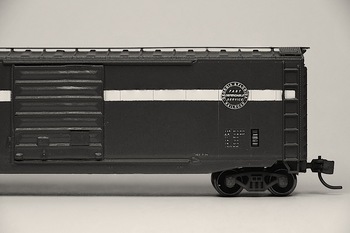 : G&F 488
: G&F 488Here are the data of the car and a belief history of the railroad.
G&F 400 - 499 series boxcars:
G&F XL #400 to 499 series boxcars were built in 1959 by Pullman-Standard.
The Official Railway Equipment Register (ORER) for October 1968 shows the group #400 to #499 with 96 cars in place, described as follows:
AAR designation XL and description “Box, All Steel” only. The inside length of these cars was 50 feet 6 inches, inside width 9 feet 2 inches, inside height 10 feet 5 inches, outside length 54 feet 7 inches, extreme height 15 feet, door opening 9 feet 3 inches, and capacity 4845 cubic feet or 110,000 pounds.
Georgia & Florida Railway/road (reporting mark G&F) was a north-south railroad with lines primarily in Georgia. The company was established in 1906 as Georgia & Florida Railway by the former Seaboard Air Line Railway president John Skelton Williams. Through acquiring and constructing, the G&F route eventually stretched between Greenwood, South Carolina, and Madison, Florida in 1910.
It was renamed to Georgia & Florida Railroad in 1926 after the reorganization. It renamed again to Georgia & Florida Railway in 1963 after the acquisition by the Southern Railway. Finally, in 1971, it was merged into Central of Georgia and the name G&F came to an end.
Part of the former G&F route in Georgia and Florida is operated by the short line railroad Georgia and Florida Railway (reporting mark GFRR), a subsidiary of OmniTRAX, since 1995.
The map below is the part of Union Pacific Map of the United States printed in 1971, with the G&F route traced in red line by the author.
The bottom is the photo of a Japanese variant of equipment with "cigar band": Japanese National Railway’s non-revenue equipment ワム66172.
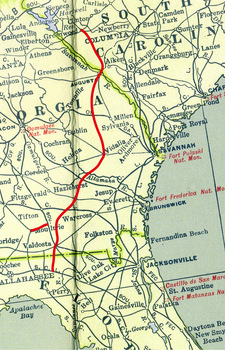 : 1966 G&F route
: 1966 G&F route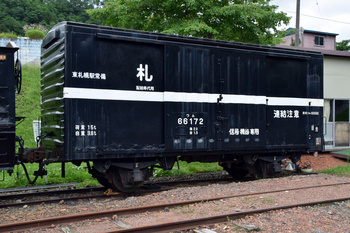 : Mikasa, Hokkaido, Japan. Aug. 26, 2018
: Mikasa, Hokkaido, Japan. Aug. 26, 20182021-05-21 09:00
コメント(0)
Paint Shop – 80 : Seaboard Air Line Boxcar 21315, part 1 [Works_Boxcars]
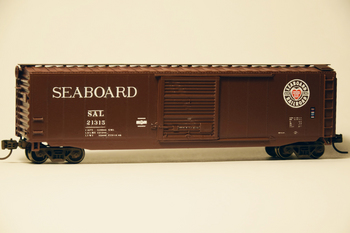 : SAL 21315
: SAL 21315In 2015, I found a Seaboard Air Line Railroad boxcar at Encino, New Mexico[1]. Since then, I planned to make the N scale model of the particular car, but I couldn’t find the decal including “THE ROUTE OF COURTEOUS SERVICE” slogan. So, at present, I decided to make SAL #21315, a similar car without the slogan: a prototype photo is found at Railroad Picture Archives site[2].
I used a surplus Athearn PS-1 single-door boxcar for the model. I changed the door with a 10’ Youngstown door copied from Atlas Master ACF 50’ Precision Box Car. As the prototype is a riveted construction car, I applied the rivets on sides with Archer Surface Details #AR88024.
I painted the body with Tamiya TS-62. Before applying decals, I polished the surface of the painted body, where decals were going to be applied, with the compound. Decal used is Microscale #60-965. I spray-painted the semi-gloss clear coat after applying the decals.
[1] 2015 photo of SAL XL #27249, Boxcar Red Collection;
[2] 1974 photo of SAL #21315, Railroad Picture Archives;
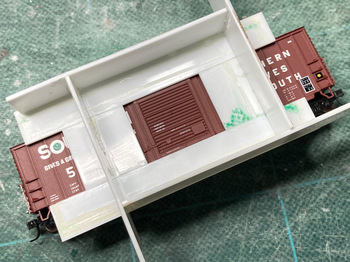 : copying the 10’ door
: copying the 10’ door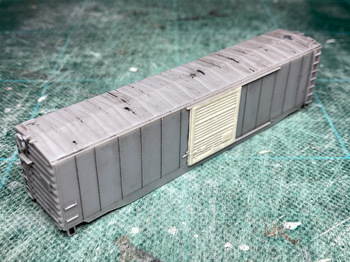 : body, ready to paint
: body, ready to paint2021-06-25 09:00
コメント(0)
Paint Shop – 81 : Seaboard Air Line Boxcar 21315, part 2 [Works_Boxcars]
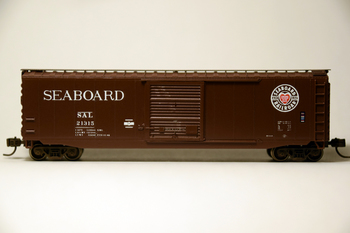 : SAL 21315
: SAL 21315Here are the data of the car and a belief history of the railroad.
SAL 21000 - 21599 series boxcars:
SAL XL #21000 to 21599 series boxcars were built in 1959 by Pullman-Standard.
The Official Railway Equipment Register (ORER) for October 1968 shows the group #21000 to #21599 with 579 cars in place, described as follows:
AAR designation XL and description “Box, Stl.” with notes “equipped with nailable steel floor and lading band anchors” and “converted from XM to XL type”. The inside length of these cars was 50 feet 6 inches, inside width 9 feet 4 inches, inside height 10 feet 6 inches, outside length 54 feet 5 inches, extreme height 15 feet, door opening 10 feet, and capacity 4863 cubic feet or 100,000 pounds.
Seaboard Air Line Railroad (reporting mark SAL) was a network of routes in the Southeastern United States connecting Florida and the northern states. The origins of the railroad were the Portsmouth & Roanoke Railroad (P&R) established in 1832 and Raleigh & Gaston Railroad (R&G) established in 1836. In 1875, P&R, R&G, and R&G subsidiary Raleigh & Augusta Air-Line Railroad (R&AA-L) formed the Seaboard Air-Line System controlled by John M. Robinson.
In 1900, John S. Williams gathered 19 railroads including the three mentioned above to create the Seaboard Air Line Railway. He also established the Georgia & Florida Railway in 1906. The Railway reached Miami in 1926 but forced to be reorganized as the Seaboard Air Line Railroad (SAL) in 1946. The Railroad finally merged with Atlantic Coast Line Railroad (ACL) to form Seaboard Coast Line Railroad (SCL) in 1967.
SCL became Family Lines System in 1972, Seaboard System in 1982, and finally CSX in 1986.
The map below is the part of the “Union Pacific Map of the United States” printed in 1971, with the 1966 SAL route traced in red line by the author.
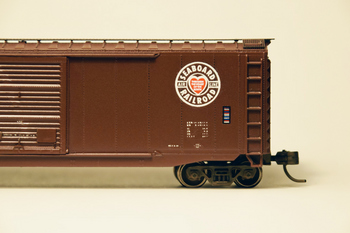 : SAL 21315
: SAL 21315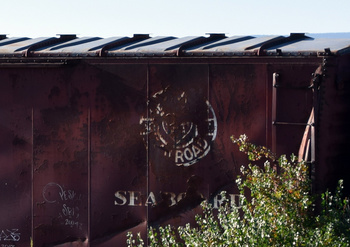 : SAL #27249 Encino, NM. Sep. 13, 2015
: SAL #27249 Encino, NM. Sep. 13, 2015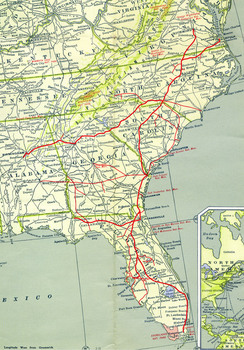 : 1966 SAL route
: 1966 SAL route2021-07-02 09:00
コメント(0)
Paint Shop – 82 : Richmond, Fredericksburg & Potomac Boxcar 2920, part 1 [Works_Boxcars]
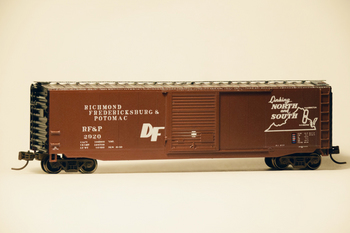 : RF&P 2920
: RF&P 2920Flagship passenger trains from Florida like Seaboard Air Line’s Silver Meteor or Atlantic Coast Line's East Coast Champion went north from Richmond through Richmond, Fredericksburg & Potomac Railroad to Washington. Accordingly, I managed to make an RF&P boxcar after SAL #21315. K4 Decals produces several water slide decals for RF&P boxcars. I chose the decal for 50 Ft Boxcar.
RF&P boxcars fit my body type, scheme, and era—50’ boxcar red boxcar with ACI plates—are relatively few: 2901 to 2925 series cars seemed the only candidate. I found a photo of #2907 at Fallen Flags site, but it was repainted with bold logotype[1]. I also found a builder’s photo of #2920 at Illinois Digital Archives site, but it of course lacked ACI plate[2]. However, fortunately, April 1974 Official Railway Equipment Roster lists 2901 to 2925 series cars with all 25 cars in place. So, I decided to make RF&P #2920 with a little promising observation of not being repainted.
I used a surplus Athearn PS-1 single-door boxcar for the model. I painted the body with Tamiya TS-62, MS-2, and TS-14. Before applying decals, I polished the surface of the painted body, where decals were going to be applied, with the compound.
Decal used is K4 Richmond, Fredericksburg & Potomac 50Ft Boxcar White RF&P. As you can see on their web page, the K4 decal exactly reproduces the prototype layout. So, if you trim off in a piece, you don’t have to nudge the decal adjusting the level and position of each marking. Also is that by trimming off in a piece, you can eliminate the edge of each marking.
I spray-painted the semi-gloss clear coat after applying the decals.
[1] 1960 builder’s photo of RF&P #2920 at Illinois Digital Archives site;
[2] 1965 photo of RF&P #2907 repainted in 1964 at Fallen Flags site;
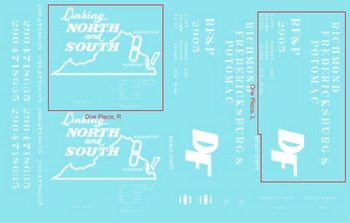 : K4 Decal trimming guide
: K4 Decal trimming guide2021-07-30 09:00
コメント(0)
Paint Shop – 83 : Richmond, Fredericksburg & Potomac Boxcar 2920, part 2 [Works_Boxcars]
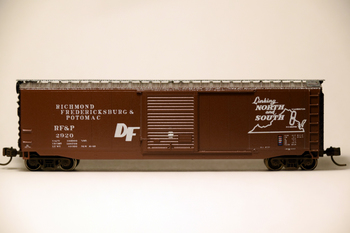 : RF&P 2920
: RF&P 2920Here are the data of the car and a belief history of the railroad.
RF&P 2901 – 2925 series boxcars:
RF&P XL #2901 to 2925 series boxcars were built in 1960 by Pullman-Standard.
The Official Railway Equipment Register (ORER) for April 1974 shows the group #2901 to #2925 with all 25 cars in place, described as follows:
AAR designation XL and description “Box, Stl. 24 Crossbearers, 10-24” & 10-48” Deck Boards, 8 Door Post Members”. The inside length of these cars was 50 feet 6 inches, inside width 9 feet 2 inches, inside height 10 feet 5 inches, outside length 51 feet 10 inches, extreme height 15 feet, door opening 9 feet, and capacity 4848 cubic feet or 100,000 pounds for #2902, 2910, 2919, and 2925/ 110,000 pounds for the rest.
Richmond, Fredericksburg & Potomac Railroad (reporting mark RFP) was a bridge line connecting Washington and Richmond. It connected Seaboard Air Line Railroad and Atlantic Coast Line Railroad at Richmond, Pennsylvania Railway, Baltimore & Ohio Railroad, and Southern Railway at Washington, and Chesapeake & Ohio Railroad at Doswell, thus boasted of itself as “Linking North & South”.
It was established in 1834 between Richmond and Fredericksburg. It reached Washington in 1870 via Alexandria & Washington Railway. In 1901, two railroads were integrated to form RFP owned by six related railroads mentioned above and the state of Virginia.
The railroads that owned RFP finally shrunk from six to three: CSX, NS, and Conrail. In 1991, CSX became the sole owner of RFP and folded the railroad into its own system.
The map below is part of the “Union Pacific Map of the United States” printed in 1971, with the 1966 RFP route traced in red line by the author.
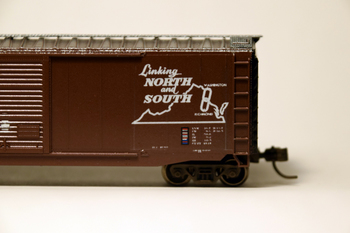 : RF&P 2920
: RF&P 2920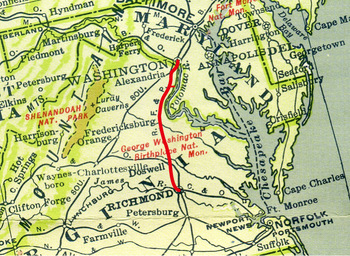 : 1966 RF&P route
: 1966 RF&P route2021-08-13 09:00
コメント(0)
Paint Shop – 84 : Norfolk Franklin & Danville Boxcar 2384, part 1 [Works_Boxcars]
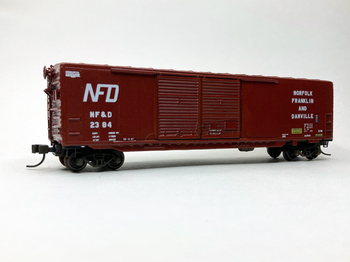 : NFD2384
: NFD2384Richmond, Fredericksburg and Potomac Railroad featured in the previous post was a “Old Dominion” railroad originated and terminated within the state of Virginia. Here is another “Old Dominion” railroad boxcar decorated with K4 Decal: Norfolk Franklin & Danville Railway XM #2384.
NF&D boxcars fit my body type, scheme, and era –50’ boxcar red boxcar with ACI plates– are listed in four groups in the April 1974 Official Railway Equipment Roster (ORER). I found a photo of #2384 in the book Classic Freight Cars The Series Vol. 8: yes, the exact number K4 produces. I immediately decided to make this car for my next project.
I used a surplus MTL Double Doors w/o Roofwalk boxcar for the model. I changed the ends and the roof: “rolling pin” Improved Dreadnaught ends came from InterMountain Railway 12 Panel 40’ Boxcar, and diagonal panel roof came from Athearn NACC Boxcar.
Accompanying hand brake set came from InterMountain Railway AAR 50’ Single Door Boxcar, while the brake wheel is the MTL product, and ladders are the Gold Medal Models product. Retaining valve seems moved from the end at the same time with the removal of the roofwalk.
Details coped with are: grab irons on roof and ends, tack board on ends, modified side sills, side panel riveted joints, and door opening stiffeners. Rivets are done with Archer Surface Details decal. Prototype drawings offered from Norfolk and Western Historical Society (NWHS) web site were very useful.
I spray-painted the body with Tamiya TS-33. Before applying decals, I polished the surface of the painted body, where decals were going to be applied, with the compound.
Decal used is K4 “Norfolk Franklin & Danville 50Ft Auto Boxcar White”. As you can see at their web page, K4 decal exactly reproduces the prototype layout. So, if you trim off in a piece, you don’t have to nudge the decal adjusting the level and position of each marking. Also is that by trimming off in a piece, you can eliminate the edge of each marking.
I finally spray painted the semi-gloss clear coat after applying the decals to finish my work.
* drawings of side steel details at NWHS;
* drawings of stenciling applies at NWHS;
* decal I used;
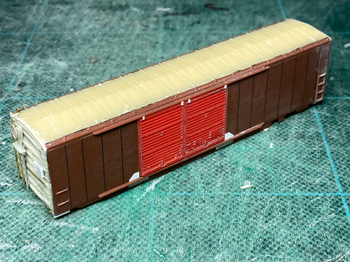 : body, ready to paint
: body, ready to paint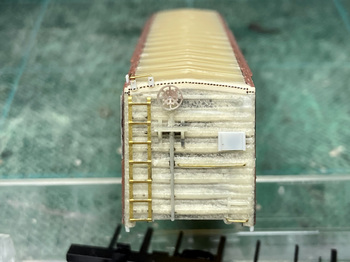 : B end details
: B end details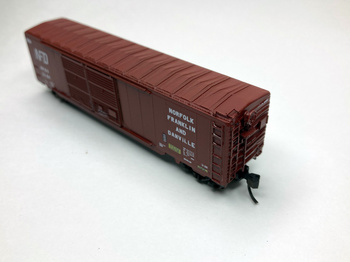 : finished model
: finished model2021-10-22 09:00
コメント(0)
Paint Shop – 85 : Norfolk Franklin & Danville Boxcar 2384, part 2 [Works_Boxcars]
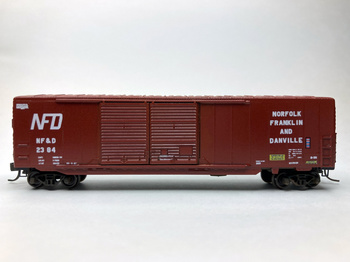 : NFD2384
: NFD2384Here are the data of the car and a belief history of the railroad.
NF&D 2341 – 2441 series boxcars:
According to Classic Freight Cars the Series vol. 8, NF&D class B-56 XM #2341 to 2441 series boxcars were built in 1967. But these Improved Dreadnaught ends with “rolling pin” ribs appear in the prototype photo were produced between 1948 and 1954. Therefore, the information offered at Norfolk and Western Historical Society (NWHS) website may be accurate: these cars are transferred in 1967 from N&W class B-56 boxcars nee NKP #86100 to #86199 built by ACF in 1949.
The Official Railway Equipment Register (ORER) for April 1974 shows the group #2341 to #2441 with all 101 cars in place, described as follows:
AAR Designation XM and description “Box, Stl. Stagg. Doors”. The inside length of these cars was 50 feet 6 inches, inside width 9 feet 4 inches, inside height 10 feet 6 inches, outside length 56 feet, extreme height 14 feet 11 inches, door opening 15 feet, and capacity 4985 cubic feet or 110,000 pounds.
Norfolk Franklin & Danville Railway (reporting mark NFD) was a little more than 200 miles line connected its namesake cities in Virginia. It was established in 1882 as the Atlantic and Danville Railway. It reached Danville in 1890. Southern Railway (SOU) leased the company between 1899 and 1949.
Norfolk and Western Railway (N&W) acquired the company in 1962 and reorganized it as Norfolk Franklin & Danville Railway. However, unfortunately, the company was dissolved in 1983 after the creation of the Norfolk Southern Corp. Few portions of the line are in use today.
The map below is the part of the “Union Pacific Map of the United States” printed in 1971, with the 1966 NF&D route traced in red line by the author.
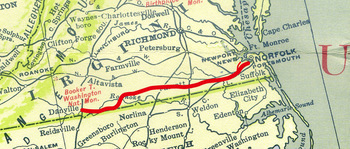 : 1966 NF&D route
: 1966 NF&D route2021-11-05 09:00
コメント(0)
Paint Shop – 86 : Penn Central Boxcar 268463, part 1 [Works_Boxcars]
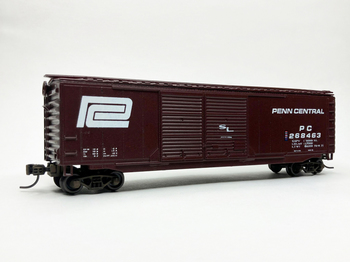 : PC268463
: PC268463Penn Central Transportation Company (PC) equipment fits my body type, scheme, and era−50’ boxcar red boxcar with ACI plates−are relatively few. This PC #268463 was the only former New York Central railroad (NYC) boxcar painted boxcar red found in my photo collection.
Despatch Shops (DSI) ends and roofs are the feature of the home-built NYC boxcars of the era. The appearance of DSI ends looks like the hybrid of Pullman ends and Dreadnaught ends, and that of DSI roof looks like the hybrid of Pullman roof and Diagonal roof.
Eastern Seaboard Models produces N scale boxcars with DSI roof and ends. But, I decided to kitbash them from the self-made resin copies of Diagonal roof and Pullman ends. Accordingly, I used Athearn PS-1 Double Door Boxcar for the model.
I scraped off the diagonal projections from the Diagonal roof came from Athearn NACC Boxcar. Then, I added the rectangular projections made of thin styrene sheet to represent the DSI roof. Finally, I replaced the Pullman roof of the Athearn model with the kitbashed DSI roof. Roofwalk is a MTL product. DSI ends are represented through scraping off the corner of the Athearn Pullman ends.
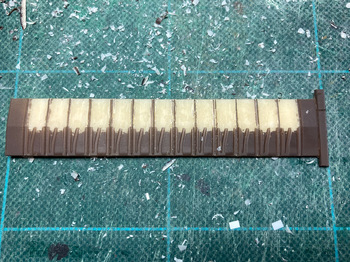 : erasing Diagonal roof
: erasing Diagonal roof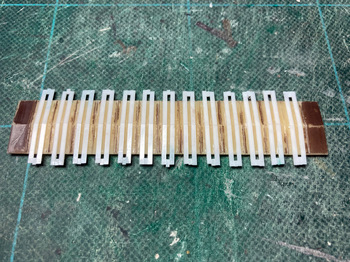 : adding DSI roof
: adding DSI roof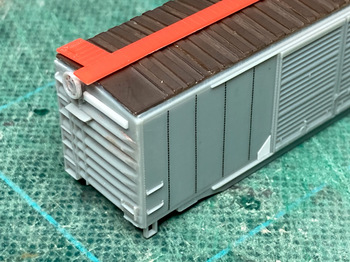 : modified B-end
: modified B-endDetails coped with are modified side sills, side panel riveted joints, and door opening stiffeners. Rivets are done with Archer Surface Details decal.
I spray-painted the body with Mr. Color No. 29. Before applying decals, I polished the surface of the painted body, where decals were going to be applied, with the compound.
Decals used are Microscale 60-1096 “Penn Central Boxcars”, and K4 “Pittsburgh & Lake Erie 50ft Boxcar”. I finally spray painted the semi-gloss clear coat after applying the decals to finish my work.
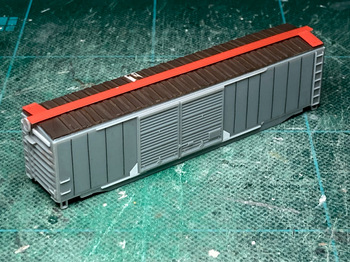 : body ready to paint
: body ready to paint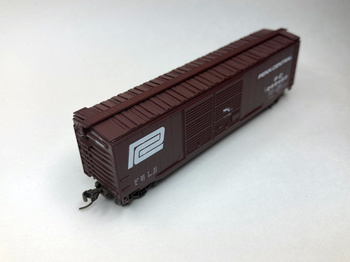 : finished model
: finished model2022-01-14 09:00
コメント(0)
Paint Shop – 87 : Penn Central Boxcar 268463, part 2 [Works_Boxcars]
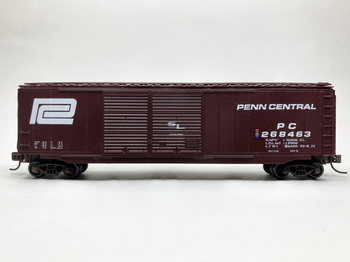 : PC268463
: PC268463Here are the data of the car and a belief history of the railroad.
PC 268412 – 268481 series boxcars:
These cars were the renumbered New York Central Railroad (NYC) equipment: former NYC 862-B class #45000 to 46899 series boxcars built by road’s Despatch Shops (DSI) at East Rochester, NY in 1957. These cars originally came with an “Early Bird Fast Freight Service” herald. Some of the cars survived into the Conrail era as CR 862B class cars.
The Official Railway Equipment Register (ORER) for April 1974 shows the group #268412 to #268481 with 23 cars accompanied by three other 90,000 capacity cars in place, described as follows:
AAR Designation XL and description “Box, Stl. Transco 7 SL Belts”. The inside length of these cars was 50 feet 6 inches, inside width 9 feet 4 inches, inside height 10 feet 5 inches, outside length 54 feet 4 inches, extreme height 15 feet 1 inch, door opening 15 feet, and capacity 4929 cubic feet or 110,000 pounds.
* 1977 photo of NYC #45745 found at Railroad Picture Archives site;
* 1977 photo of PC #268173 in Penn Central Green found at Railroad Picture Archives site;
* 1976 photo of CR #171291 found at Conrail Photo Archive site;
Penn Central Transportation Company (reporting mark PC) was created through the merger of two railroads, New York Central Railroad (NYC) and Pennsylvania Railroad (PRR) in 1968. Next year, New York, New Haven and Hartford Railroad (NH) joined the consortium.
However, unfortunately, it went bankrupt in 1970. It was reorganized with other six railroads as Consolidated Rail Corporation (Conrail) in 1976. Conrail was split into two and absorbed into CSX and NS in 1999.
The map below is the part of “Union Pacific Map of the United States” printed in 1971, with the 1966 NYC, PRR, and NH routes traced in pink, red, and orange lines respectively by the author.
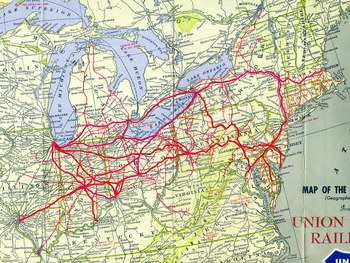 : 1966 NYC, PRR and NH routes
: 1966 NYC, PRR and NH routes2022-01-28 09:00
コメント(0)
Paint Shop – 88 : Penn Central Boxcar 270047, part 1 [Works_Boxcars]
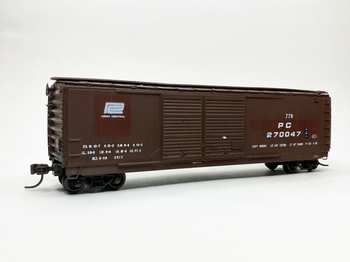 : PC270047
: PC270047Penn Central Transportation Company (PC) equipment fits my body type, scheme, and era–50’ boxcar red boxcar with ACI plates–are relatively few. I previously modeled former NYC car. So, I decided to model former Pennsylvania Railroad car this time. This PC #270047 was the only former PRR boxcar painted boxcar red found in my photo collection.
I used Athearn PS-1 Double Door Boxcar for the model. I changed the roof and ends with copied Diagonal roof and Improved Dreadnaught ends. Roofwalk is a MTL product. I modified the side panel riveted joints using Archer Surface Details decal. Side sills are also modified. Stirrups are changed with BLMA parts.
I spray-painted the body with TAMIYA TS-69, and TS-62 for the patches. Before applying decals, I polished the surface of the painted body, where decals were going to be applied, with the compound.
Decals used are Microscale 60-1096 “Penn Central Boxcars”, 60-1205 “Pennsylvania Railroad 50’ Boxcars”, and K4 “Pittsburgh & Lake Erie 50ft Boxcar”. I finally spray painted the mat clear coat after applying the decals to finish my work.
2022-02-25 09:00
コメント(0)
Paint Shop – 89 : Penn Central Boxcar 270047, part 2 [Works_Boxcars]
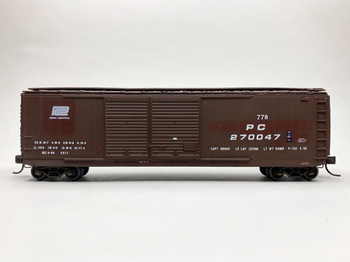 : PC270047
: PC270047Here are the data of the car and a belief history of the railroad.
PC 270047 boxcar:
This car is a renumbered Pennsylvania Railroad (PRR) equipment: one of former PRR X51c class #82100 to 82497 or #83802 to 84301 series boxcars built by road’s Samuel Rea Shops at Hollidaysburg, PA in 1956. Some of the PRR X51c cars survived into the Conrail era as CR X51c class cars.
The Official Railway Equipment Register (ORER) for April 1974 shows PC #270047 as the single car for the group, accompanied by nine other former PRR X51 and X51c cars in other groups, described as follows:
AAR Designation XL and description “Box, Stl. Stagg. Doors, Racks, Nailable Stl. Flr. in Doorway, (universal Fittings), X51c”. The inside length of this car was 50 feet 6 inches, inside width 9 feet 4 inches, inside height 10 feet 6 inches, outside length 54 feet 6 inches, extreme height 15 feet, door opening 15 feet, and capacity 4949 cubic feet or 100,000 pounds.
* 1975 photo of PRR class X51c #82128 found at Rob’s Pennsy home page;
* 1977 photo of PRR class X51c #82390 found at Railroad Picture Archives site;
* 1979 photo of CR class X51c class #210554 found at Conrail Photo Archive site;
Penn Central Transportation Company (reporting mark PC)
See Paint Shop – 87 : Penn Central Boxcar 268463, part 2
2022-03-11 09:00
コメント(0)
Paint Shop – 90 : Akron, Canton & Youngstown Boxcar 1916, part 1 [Works_Boxcars]
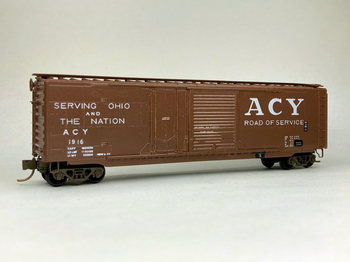 : ACY1916
: ACY1916Richmond, Fredericksburg and Potomac Railroad, and Norfolk Franklin & Danville Railway I featured in the previous posts were the “Old Dominion” railroad initiated and terminated within the state of Virginia. This time, I managed to model the “Buckeye State” railroad boxcar decorated with K4 Decal: Akron, Canton & Youngstown Railroad XM #1916.
I chose #1916 for the project because it seemed the only ACY boxcar fit my body type, scheme, and era: 50’ boxcar red boxcar with ACI plates: the rest of the cars in the same series wore yellow with black letterings according to the Railroad Picture Archives site.
I used a surplus MTL 50' Standard Box Car, w/Plug Door & Sliding Door for the model. However, unfortunately, the MTL product had 8’ sliding and plug doors contrary to the prototype’s 9’ sliding door and 6’ plug door. So, I removed the model’s doors and reinstalled the accurate doors. 9’ sliding door came from Athearn product and 6’ plug door came from MTL product. Other details I coped with were side panel joints, extended door rails, some rivets, and door opening stiffeners. I also moved the doorstops molded to the MTL product.
I spray-painted the body with Tamiya TS-62. Before applying decals, I polished the surface of the painted body, where decals were going to be applied, with the compound. The decals used are K4 “Akron, Canton & Youngstown White on Brown 40Ft Boxcar”, “Akron Canton and Youngstown 50 Ft Boxcar White ACY”, and some details from Microscale products. I finally spray-painted the semi-gloss clear coat after applying the decals to finish my work.
* 1978 photo of ACY #1916 at Railroad Picture Archives site;
* decals I used;
“Akron, Canton & Youngstown White on Brown 40Ft Boxcar”
“Akron Canton and Youngstown 50 Ft Boxcar White ACY”
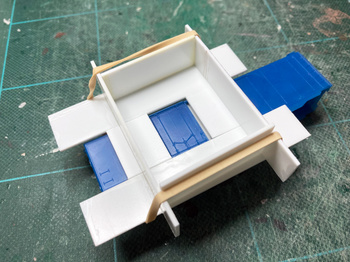 : copying the MTL plug door
: copying the MTL plug door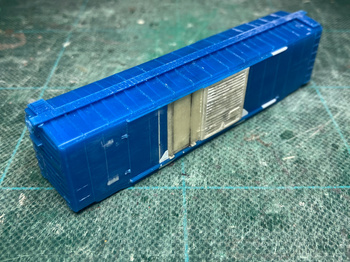 : modified body ready to paint
: modified body ready to paint2022-04-08 09:00
コメント(0)



